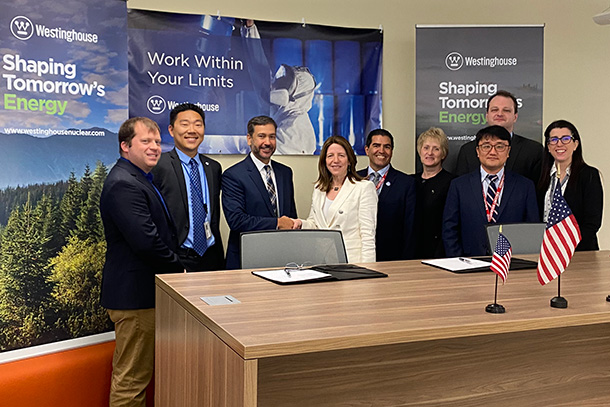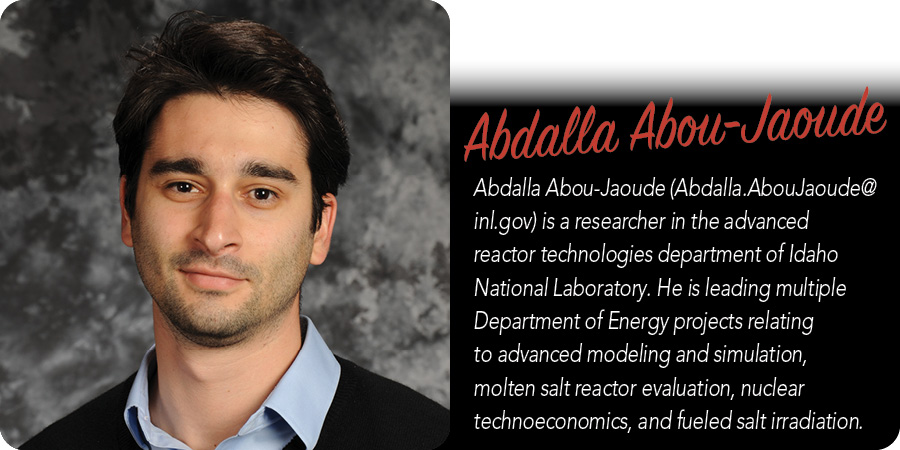Boise State University students visiting the site of the first nuclear-generated electricity in 1951 at EBR-I. (Photo: BSU)
Earlier this month, the ANS Board of Directors approved the creation of two new student sections—Reed College in Portland, Ore., and Boise State University in Boise, Idaho.
ANS’s student sections represent the next generation of nuclear—they are critical to the Society’s goal of aiding the next generation in their pursuit of advancing, fostering, and promoting the development and application of nuclear sciences and technologies for the benefit of humankind. Student sections provide students with the knowledge, tools, and opportunities required to achieve success in or out of the nuclear field.

Representatives from Westinghouse and Penn State met at Westinghouse headquarters to sign a memorandum of understanding and enter a partnership focused on researching and developing microreactors. From left: Jason Beebe, director of the global transformation office at Westinghouse; Michael Valore, senior director of advance reactor commercialization, Westinghouse; Mike Shaqqo, senior vice president of advanced reactors, Westinghouse; Lora Weiss, senior vice president for research at Penn State; Jean Paul Allain, head of the Ken and Mary Alice Lindquist Department of Nuclear Engineering at Penn State; Geanie Umberger, associate vice president for research and director of industry research collaborations at Penn State; Saya Lee, assistant professor of nuclear engineering; Elia Merzari (back), associate professor of nuclear engineering; and Hilary Ruby, director of transformation for the Americas Operating Plant Services Business Unit at Westinghouse. (Photo: Westinghouse)
Artist’s rendering of USNC spacecraft using EmberCore. (Image: DIU)
The Defense Innovation Unit (DIU), a Department of Defense organization focused on swiftly putting commercial technology to use in the U.S. military, has awarded contracts for two nuclear technologies—compact fusion and radioisotope heat—for spacecraft that could carry a high-power payload and freely maneuver in cislunar space. The objective is to accelerate ground and flight testing and launch a successful orbital prototype demonstration of each approach in 2027.
Fort St. Vraine (Photo: NRC)
In a May 15 piece, the editorial board of The Denver Gazette has weighed in on Colorado’s continuing controversy regarding how the state gets its electricity. While the current discourse in the state primarily pits fossil fuels against wind and solar, the board asks, “How about an energy source that generates almost limitless power, leaves no carbon footprint, and produces practically no emissions? It’s nuclear power—as green as you can get.”
The NNSA's ERICA initiative aims to provide resources to develop resiliency against climate-related obstacles like the 2021 shuttering of the Pantex
Plant due to the polar vortex. (Image: NNSA)
The Department of Energy’s National Nuclear Security Administration is establishing an Energy Resilient Infrastructure and Climate Adaptation (ERICA) initiative, which will help position it to deal with climate issues. In a recent press release, the NNSA noted that ERICA will help it to meet the requirements of federal legislature and executive orders, along with the DOE’s climate adaptation, energy resilience, and sustainability goals in support of the agency’s national security missions.
The initiative was outlined in President Biden’s fiscal year 2023 budget request for the DOE.
Conceptual site layout for the VTR, as shown in the Final EIS. (Image: DOE-NE)
The Versatile Test Reactor, a custom-designed sodium-cooled fast neutron spectrum test reactor, is one step closer to its goal of providing data to accelerate research, development, and demonstration of diverse advanced reactor designs. The Department of Energy released the Final Versatile Test Reactor Environmental Impact Statement (Final VTR EIS) on May 13, and 30 days after its anticipated May 20 publication in the Federal Register, the DOE will issue a Record of Decision on the project.
PSFC director Dennis Whyte (left) and CFS chief executive officer Bob Mumgaard in the test hall at MIT’s Plasma Science and Fusion Center. (Photo: Gretchen Ertl, CFS/MIT-PSFC)
The Massachusetts Institute of Technology’s Plasma Science and Fusion Center (PSFC) recently announced it will expand its involvement in fusion energy research and education under a new five-year agreement with Commonwealth Fusion Systems (CFS), a fusion energy company that got its start at MIT and is now building what it says will be the world’s first net-energy fusion machine—the demo-scale SPARC.
“CFS will build SPARC and develop a commercial fusion product, while MIT PSFC will focus on its core mission of cutting-edge research and education,” said PSFC director Dennis Whyte in describing the collaboration.














 ANS has recently published a new standard:
ANS has recently published a new standard:
